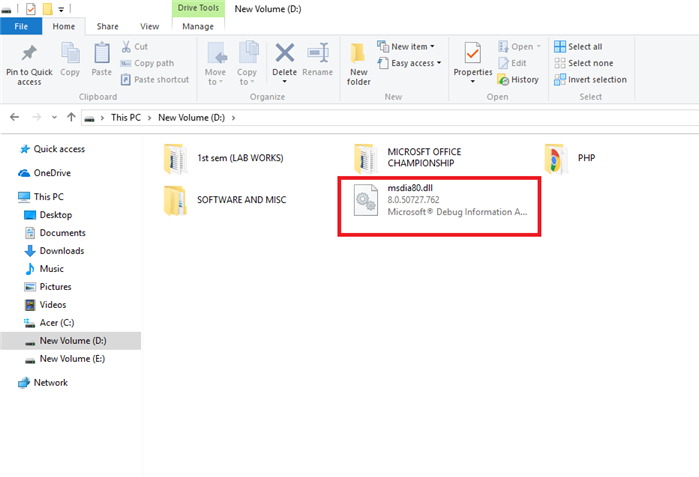Microsoft Visual C++ is an integrated development environment for programming languages- C, C++, and C++/CLI, and msdia80.dll is one of its system files. To understand what exactly is msdia80.dll let’s first take a look at DLL that is Dynamic Link Library.
Dynamic Link Library is a package that contains essential codes for programs that can be accessed by a Windows program. These programs generally use the languages C or C++. The best part about DLL is that many users can use it at once as it is a Read-Only File, and it ensures smooth functioning of the programs.
Contents
What is Msdia80.dll?
If you have installed the Microsoft Visual C++ 2005 Redistributable Package on your Windows operating system, you will definitely see msdia80.dll in your local disk C root folder. But it should be noted that the original path of the msdia80.dll is not the root directory; it is with all other DLL files in C Drive.

It is only in the above-mentioned case when it gets into your root folder. However, if it is present in other drives apart from C, it primarily means that you’ve installed some other application that uses this library.
What Should You Do About the msdia80.dll File?
First, there is nothing to worry about a DLL file because it is not a virus that will corrupt your system. Then, you must be thinking should I delete it or not?
Undoubtedly, most of the experts are against deleting the msdia80.dll file. It is just a basic set of codes, after all, that ensures efficiency when the need arises.
At times, you might find this file in every drive of your computer, which makes you think it is a virus, and you tend to delete it from everywhere. Although deleting the msdia80.dll file won’t cause any considerable problems, yet it is not advisable.
Therefore, in this section, we will provide you with two solutions that will help you relocate the file effortlessly:
Solution 1: Relocating the DLL File
If you see the msdia80.dll file on every drive or the root directory and you don’t want it, all you have to do is just move it to your boot drive. Boot Drive is the drive where your Windows is installed. Following are the steps to relocate the DLL file from the root directory to the VC folder of your Boot Drive:
Step 1: First, go to the Quick Access by pressing the Windows key and E together.
Step 2: Navigate to the folder where the msdia80.dll file is situated.
Step 3: Right-click on the file and click on Cut.
Step 4: Navigate to the C drive by following the given path location:
C:\Program Files (x86)\Common Files\microsoft shared\VC
Step 5: Paste the file in by right-clicking on at a space.
Step 6: A user account control window pops up for you to provide the administrator with permission to move this folder. Click Continue.
Now, once the relocation of the file is complete, you need to make sure you register it. Below are the steps to register your file:
Step 1: Press Windows and S keys and type the Command prompt in the dialogue box.
Step 2: Right-click on the application and select Run as Administrator.
Step 3: Finally, execute the following command as it is
regsvr32 “C:\Program Files (x86)\Common Files\microsoft shared\VC\msdia80.dll”
Step 4: Restart your computer.
Solution 2: Installing Microsoft Visual C++ Packages
If Solution 1 does not work for you, you can try this solution to fix the issue. There are two packages you need to install for this solution. So, before starting, ensure there is a stable internet connection available. Following are the steps you need to follow:
Step 1: First, open your browser and go to Microsoft Visual C++ 2005 Service Pack 1 Redistributable Package ATL Security Update.
Step 2: Secondly, select ‘vcredist_x86.exe‘ and ‘vcredist_x64.exe‘ from the list and download them.
Step 3: Afterwards, run the executables and install them. Make sure to launch them by right-clicking and selecting Run as Administrator.
Step 4: Again, go to the Microsoft Visual C++ 2005 Service Pack 1 Redistributable Package MFC Security Update.
Step 5: Select vcredist_x86.exe‘ and ‘vcredist_x64.exe‘ from the list and download them.
Step 6: Just like Step 3, run the executables and install them.
Step 7: Finally, all the packages have been installed, hence Restart your computer to see if the problem persists.
Conclusion
In case none of the solutions works for you, do not stress. As mentioned earlier DLL files cause no harm to your computer. Therefore, you can leave them as it is in the root directory, and still, your programs will function normally.
Again, we had said do not delete it but still, if you wish to delete it, all you have to do is right-click on the msdia80.dll and press Delete. It will be deleted from your system.






























